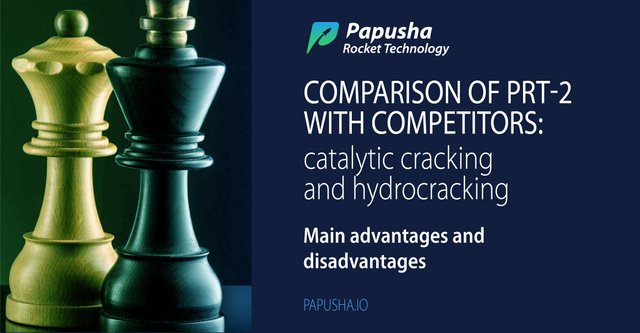Comparison of PRT-2 with competitors: catalytic cracking and hydro cracking. Main advantages and disadvantages

Petroleum tailings are unavoidable in the oil refining industry, the amount of them depends on the depth of primarily crude oil processing.
From the whole amount of refined oil in Russia (284,8 million tons in 2017) share of light oils (petrol, kerosene, diesel fuel) was 62,1%. Hence, about 35% were fuel oil and heavy petroleum residues (mainly tar, vacuum gas oil, etc.).
The reasons for such inefficient oil refining in Russia are gradual depletion of high-quality oil and shift to low-gravity oil use or use of others undeveloped fuel resources and export sale of high-quality oil.
Many oil refineries were engineered more than 30 years ago with the purpose of high-gravity oil processing. The possibility of processing cheaper low-gravity oil depends on the limitations of the equipment. Many oil refineries revise their projects for low-gravity oil processing. It is acknowledged that the most cost-effective way of heavy petroleum residues processing is one with the maximal output of engine fuel (petrol, diesel fuel), but this way requires significant investment outlay. For this reason, many scientists and researchers are working on new technologies that would advance the efficiency of the process.
Increased depth of processing can be reached with help of implementation of secondary processing of petroleum tailings to oil refineries operation process. However, these time-tested methods turn out to be ineffective, complex or simply unacceptable and require significant investment outlay.
For example, catalytic cracking method of processing of vacuum gas oil apart from main operation phase also includes two additional phases - hydrotreating of source vacuum gas oil and hydrotreating of its cracking products (gasoline and diesel fractions) from sulfur compounds – and hydrocracking requires the use of complicated technology and high hydrogen pressure.
Hydro cracking is one of the most dangerous processes of oil refining, in case of loss of control temperature excursion leads to the explosion of the reaction section. In Russia in the 2000s in a range of major plants in Perm, Yaroslavl and Ufa, hydrotreaters were reconstructed for light hydrocracking process. Financial expenses for the construction were estimated to be more than 300 million USD. In addition, the size of such equipment can cause difficulties in implementation (height of a rocket-reclaimer complex is from 30 to 55 m, diameters of separator and reclaimer – 8 and 11 m). Small and medium-size oil refineries can’t afford such expensive, hazardous and complex technologies.
In case, when oil refineries can’t process heavy petroleum residues, the latter are utilized as components of burner fuel.
Processing tar into burner fuel is being dated because of strict environmental requirements to fuel (burner fuel from oil waste is low-quality) and because of the total shift to gas use in power generating systems.
Compact mobile PRT-2 units for heavy petroleum residues (heating oil, tar) processing into engine fuel (petrol, kerosene, diesel fuel) based on transonic combustion will be interesting for small and medium-size oil refineries.
The main purposes of PRT-2 are to improve the efficiency of other oil waste processing, reduction in input of materials and significant reduction environmental influence. Main advantages in more depth:
• The end product from waste as raw materials;
• Maximized economic efficiency from processing (main raw materials, oil waste, are easy to access and end product (engine fuel) always in demand);
• Equipment is reliable (Technical implementation is realized on basis of aerospace and aviation high technologies);
• The compact size of the unit;
• Implementation of the method of processing tar into engine fuel doesn’t require changes in technological workflow.
• Low capital outlay (in comparison to conventional methods);
• High efficiency;
• Reduction of environmental influence from storage oil waste on plants, reduction in environmental charges;
• Far-sighted use of resources;